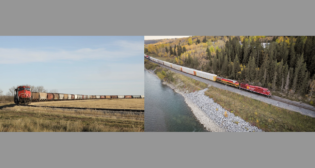
Investors focus on pricing power
Written by AdministratorThe economic downturn brought a great deal of hardship to carriers across the supply chain. Many shippers took the opportunity to re-bid their trucking contracts out of cycle, placing even more pressure on companies in the trucking sector.
Although one cannot ignore the impact of strong double-digit carload declines, the railroads were not only able to hold the ground on pricing but actually increase it during this period. Their ability to increase prices, however, has dwindled from 5-6% in 2008, 4-5% in 2009 to just under 4% in 1Q 2010. A slowdown in the economy may have had some customers balking at rate increases, but falling truck rates definitely exacerbated the pressure as well.
Although many of the railroads should be commended for reducing operating expenses and improving service levels during the downturn, it is their ability to push through pricing increases that kept earnings from falling even more than they did during this period. In contrast, many trucking companies saw their earnings drastically reduced with a few companies posting a loss for all of 2009. Hence it is not surprising that investors remained acutely focused on pricing power at the railroads.
Despite some trepidation, we believe that 1Q may be the trough for railroad pricing. Indeed, rails are seeing strong demand for their services as carloads are up 10.9% in 2010 and 17.7% thus far in 2Q. Demand has been so strong for some intermodal services that rails are running out of equipment in some locations. While this alone would be reason for continued strength in pricing, the rails are finally getting some relief from downward pressure on trucking prices. In fact, trucking prices are not only recovering, they are recovering at a very rapid pace. According to a major truckload carrier with whom we met recently, spot rates started off the year at $1.24 per mile, increased to $1.70 per mile by the end of 1Q, jumped to $1.85 per mile in May and kicked off June over $2.00 per mile. This is not only driving some business back to the railroads, but is raising the ceiling on what railroads can charge on truck competitive intermodal lanes.
We expect trucking prices to continue to rise as the economny continues to recover and capacity remains under pressure. Many trucking firms have left the industry since the economic malaise while several large surviving firms severely pared down their fleets. To make capacity matters worse, many carriers are having a difficult time finding qualified drivers. This is an issue that may not go away anytime soon. New regulations (CSA 2010) should limit the driver pool further and replacements may not be easily available as numerous driving schools shut their doors during the downturn.
Given the trajectory of supply/demand in the trucking market and the demand for rail business in general, we believe that 2011 will see stronger pricing than 2010 for the railroad carriers. This improved pricing, along with the aforementioned carloading gains, should help drive earnings. However, some investors worry that the railroad carriers will not be able to push the revenue from the increased traffic to the bottom line. Many have pointed to the problems that the rail industry had during the last recovery period in 2002. We have identified three important adjustments the railroads have made that weaken the view that railroads will be unable to maintain a low cost structure as freight volumes return.
First, railroads now have a better strategic approach to cost cutting. Instead of firing staff as they did in the previous recovery, the railroads shifted to furloughing employees, which should enable the companies to re-staff in the span of a few weeks as opposed to months. Second, the railroads have spent roughly $40 billion on infrastructure upgrades, maintenance, and new projects, significantly improving their networks to avoid future recovery-related congestion. Third, unlike the previous recovery, the railroads have access to locomotives and cars in storage, which they can utilize at lower incremental cost as traffic improves.
Like all stocks, the railroad group is not without its risks. The most notable risks in our view are the sustainability of the economic recovery and the impact of pending Congressional Bills on the industry’s ability to earn acceptable returns (given the current pace on Capital Hill this could be pushed out until 2011). That said, we continue to believe that railroad stocks are a solid choice for investors seeking transportation exposure in their portfolios. Not only do we believe that the railroads will have strong earnings growth but there is a chance for investors to see some support from strong free cash flow generation. Railroads are likely to utilize this free cash, along with record amounts of cash already on hand, to support their shares through repurchase programs and boost dividends (investors should note that we have recently seen evidence of both practices occurring). Both options should bode well for investors over the longer term.
Please refer to http://www.dahlmanrose.com for appropriate financial disclosures.



